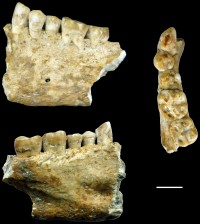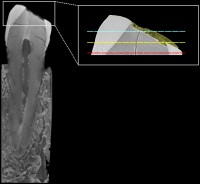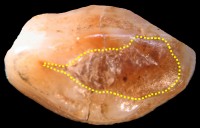 Researchers at the Abdus Salam International Centre for Theoretical Physics (ICTP) in Trieste, Italy have discovered what may be the oldest example of therapeutic palliative dentistry in the 6500-year-old canine of a young man. It’s a beeswax filling that covers sensitive dentin exposed by wear and a vertical crack, and it’s so subtle that it took scientists more than a hundred years to notice it. The wear is profound enough that it was probably not incurred in regular chewing of food but from tougher activities the Neolithic put their teeth to, like making tools or softening leather.
Researchers at the Abdus Salam International Centre for Theoretical Physics (ICTP) in Trieste, Italy have discovered what may be the oldest example of therapeutic palliative dentistry in the 6500-year-old canine of a young man. It’s a beeswax filling that covers sensitive dentin exposed by wear and a vertical crack, and it’s so subtle that it took scientists more than a hundred years to notice it. The wear is profound enough that it was probably not incurred in regular chewing of food but from tougher activities the Neolithic put their teeth to, like making tools or softening leather.
The tooth is part of a mandible fragment found embedded in the calcite wall of a karstic cave in Loka, Slovenia in 1911. Bones of an Upper Pleistocene cave bear were discovered there as well, which suggested the jawbone was one of the most ancient human remains ever found in the area. The mandible with its one canine, two premolars and first two molars was donated to the Natural History Museum of Trieste by the finders. (Loka, called Lonche in Italian, was at that time part of the Austro-Hungarian Empire as was nearby Trieste.) Aside from a minor article published in 1937, there’s been no study of the bone. There aren’t even any detailed contemporary records of the context of the find.
This year ICTP researchers asked the Natural History Museum of Trieste to loan them the Lonche jaw for use in their ICTP-Elettra EXACT Project, which gives scientists working in developing countries access to advanced technologies for a proposed study. It was those state-of-the-art gadgets that spotted the beeswax filling on the canine and narrowed down the dates of both filling and tooth. Accelerator mass spectrometry analysis of collagen from inside the jawbone provided a radiocarbon date range of 6655-6400 years old. AMS radiocarbon dating of the beeswax filling matched the mandible’s age almost exactly, returning a range of 6645-6440 years old. That means the beeswax was not a later addition but rather was applied shortly before or shortly after the death of the 24-to-30-year-old man whose jaw it was.
 The entire canine was scanned with X-ray micro-CT, and the upper left part where the beeswax is concentrated was also scanned using synchrotron radiation micro-CT. What you get with this technology is extremely detailed imaging, in this case a complete 3D picture with resolutions in the range of 9 to 18 micrometers (a micrometer is one one-thousandth of a millimeter). With this incredibly close view, researchers were able to see that the vertical crack on the canine went deep inside through the enamel to the dentin and that the beeswax filling penetrated the crack for almost a millimeter and a half.
The entire canine was scanned with X-ray micro-CT, and the upper left part where the beeswax is concentrated was also scanned using synchrotron radiation micro-CT. What you get with this technology is extremely detailed imaging, in this case a complete 3D picture with resolutions in the range of 9 to 18 micrometers (a micrometer is one one-thousandth of a millimeter). With this incredibly close view, researchers were able to see that the vertical crack on the canine went deep inside through the enamel to the dentin and that the beeswax filling penetrated the crack for almost a millimeter and a half.
Scanning electron microscope analysis of the surface of the tooth revealed that the beeswax filled the entire area of exposed dentin and that it also filled tiny little chips along the length of the fracture. It seems, therefore, that this filling was deliberately applied to assuage the pain of dentin exposed by wear and tear. Although there is evidence of earlier dental work — 7,500-9,500-year-old molars found in Pakistan six years ago had regularly shaped cavities with concentric ridges indicating they were drilled by what had to have been agonizingly painful stone tools — this filling is the earliest direct evidence of dental work done to assuage pain rather than to remove potentially dangerous tooth decay.
 The dating does leave open the possibility that the filling was added after death, perhaps for ritual purposes. We don’t know a great deal about the Neolithic inhabitants of the northern Adriatic coast, but there is zero evidence of such a practice. The application of the wax down the length of the fracture filling in the chips along the edges suggests that the wax wasn’t applied to the crown and then drawn down into the crack after death. Also, the other teeth have cracks that also expose dentin, but none of them were filled. That indicates that the owner of the teeth found one particularly painful and sought a remedy while still very much alive.
The dating does leave open the possibility that the filling was added after death, perhaps for ritual purposes. We don’t know a great deal about the Neolithic inhabitants of the northern Adriatic coast, but there is zero evidence of such a practice. The application of the wax down the length of the fracture filling in the chips along the edges suggests that the wax wasn’t applied to the crown and then drawn down into the crack after death. Also, the other teeth have cracks that also expose dentin, but none of them were filled. That indicates that the owner of the teeth found one particularly painful and sought a remedy while still very much alive.
The team plans to investigate whether there are other similar indications of Neolithic palliative dentistry which have been overlooked until now because they’re so hard to spot with the naked eye. They will examine Neolithic teeth from various places in Europe and see what they find. It would be neat if it turned out that Stone Age people had widely established therapeutic dentistry practices and we just didn’t know to look for them.
An interesting home remedy for toothache bees wax must be much more stable than one would have thought. I remember my Grandfather used gutta-percha as his home remedy for filling cavities, a technique he learned in the trenches during WWI.
:boogie: Paleolithic palliative dentistry would be neat, indeed.
One of the reasons I love history is because it links me to my ancient doppelgangers. So many people think that technology = intelligence and discount those whose lives mirrored ours because they didn’t text in traffic. Every time I find some little nubbin that shows that they not only shared our problems but found useful ways of dealing with them, my reaching back to them becomes easier and more real.
Although, I would have hated a dentist in furs as much as I do one in a white coat. 😮
This, this, a thousand times this. I could not agree more. One of my greatest pet peeves in popular history books is when people in the past are treated as some alien species entirely different from us. We’ve been consistently inconsistent since we came down from the trees, you know? And I love seeing us in all our talent and all our insanity.
We’ve only been relatively civilized for about 15,000 years. That isn’t enough time for us to have changed, as a species, no matter how much our environment has altered.
People don’t think about it but I’ll be Og complimented Oga on her mammoth steak dinner and Oga reminded him that she needed a new sabre-tooth fur the next time he went out. Not to mention that it was time to see the dentist.
We are what we were.